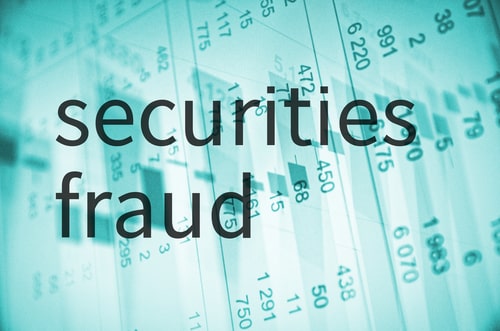Little Known Questions About Securities Fraud Class Actions.
Wiki Article
Some Known Questions About Securities Fraud Class Actions.
Table of ContentsFascination About Securities Fraud Class ActionsThe Ultimate Guide To Securities Fraud Class ActionsSecurities Fraud Class Actions for DummiesThe smart Trick of Securities Fraud Class Actions That Nobody is Talking About
A vital requirement of the assumption is that an alleged falsehood should have in fact had some impact on the cost of the safety and security traded by the complainants; or else, the complainant can not be claimed to have actually counted on the fallacy, even indirectly.In between 2002 and 2004, virtually half of all pending course activities in federal courts were securities related. An additional rise is currently underway. Since 2012, securities-fraud matches have actually continuously raised yearly; most lately, there was a 7. 5% year-over-year rise in 2016 and an added 15. 1% dive in 2017.
The PSLRA raised begging requirements and consisted of several other reforms; notably, the original draft of the Act would certainly have gotten rid of the Standard presumption entirely. While the PSLRA did reduce pointless claims to some level, the proceeding surge in securities-fraud class activities suggests that too much lawsuits stays a significant problem.
At a minimum, after that, there seems assistance in the courts, the academy, and the legislature for both (1) lowering meritless securities-fraud filings and (2) ensuring that such cases, once submitted, do not endure the motion-to-dismiss or class-certification phases of lawsuits. A possibility to accomplish one or both of these objectives with judicial intervention occurred in Halliburton II.
A Biased View of Securities Fraud Class Actions
Halliburton II: The Supreme Court's Feedback to the Rise Halliburton II marked the second time that the long-running course action versus Halliburton Co. for supposed safety and securities fraudulence after that in its thirteenth year had actually been before the High court. In 2011, the celebrations had clashed over whether complainants need to verify loss causation prior to or after class accreditation.As to the initial concern, the Court decreased to overrule Basic - Securities Fraud Class Actions. Creating for the bulk, Chief Justice Roberts kept in mind that stare decisis counsels versus reversing classic precedent like Standard without "special reason"; Halliburton's disagreements did not satisfy this demanding standard. Halliburton got on better relative to the 2nd question: the Court held that the Fundamental presumption can be rebutted before class qualification
He thought an in contrast ruling would certainly be strange since the identical evidence that offenders would introduce to reveal that there was no rate impact was already acceptable before class qualification in order to counter a component of the Fundamental assumption. If the evidence failed to counter that component of the anticipation but did show that there had been no rate impact, a district court would have to blind itself to this truth and license the course under the fraud-on-the-market theory, even though the concept was simply not appropriate.
In answering both inquiries offered, Principal Justice Roberts took care to prevent stepping right into the perky policy discussion over 10b-5 course activities. Halliburton did try to increase plan problems for instance, that securities-fraud class activities might "enable complainants to extort huge negotiations. for meritless claims." The Principal Justice stated that these kinds of concerns were "much more properly dealt with to Congress," directing out that Congress had actually proven itself willing to react to "viewed abuses" of 10b-5 course activities by passing the PSLRA.
The Ultimate Guide To Securities Fraud Class Actions
He would have overruled the Standard presumption, which in his sight has actually led to "an unrecognizably wide source of action all set made for class qualification" that is inconsistent with both the economic literature and the Court's subsequent class-certification caselaw. Doubting that an opportunity for pre-certification counterclaim would certainly achieve a lot, Justice Thomas competed that as an useful matter answer had actually so far proven virtually impossible and would continue to be so also if allowed prior to class accreditation.Commentators and good sense alike recommended that by managing defendants a possibility to beat meritless insurance claims prior to a class was accredited (and before the pressures to settle became frustrating), Halliburton II would certainly permit those meritless claims to really be beat at a purposeful rate. However this Component suggests that Halliburton II's promise was try these out an impression and could have been determined therefore on the day that the choice was provided, for one straightforward factor: the price-maintenance theory. Securities Fraud Class Actions.

Theoretically, the rate influence to be rebutted can appear in 2 methods. The first supposed "front-end" rate effect is noticeable: a misstatement can cause a shift in market assumptions regarding a safety and set off an immediate swing in its cost. Presume the market expects a company to make profits of $100, the firm actually does earn a fantastic read $100, however the CEO exists and reports earnings of $125.
Since the market's expectations were met, the rate of the business's supply must stay secure at the pre-misrepresentation standard. Nevertheless, the price-maintenance concept holds that there is cost impact, because the misrepresentation stopped the market rate from dropping as it would certainly have if the chief executive officer had actually levelled. Right here, as well, inflation will certainly dissipate when a corrective disclosure leads find the marketplace to include the reality into the marketplace cost.
The Ultimate Guide To Securities Fraud Class Actions
Rather, offenders must reveal that none of the cost activity on the date of a supposed restorative disclosure was associated with the disclosure. This is an uphill struggle. There will often be some rate motion on that particular day, due to the fact that plaintiffs commonly file 10b-5 fits in the wake of a substantial rate modification alleging it was the result of a rehabilitative disclosure.

Report this wiki page